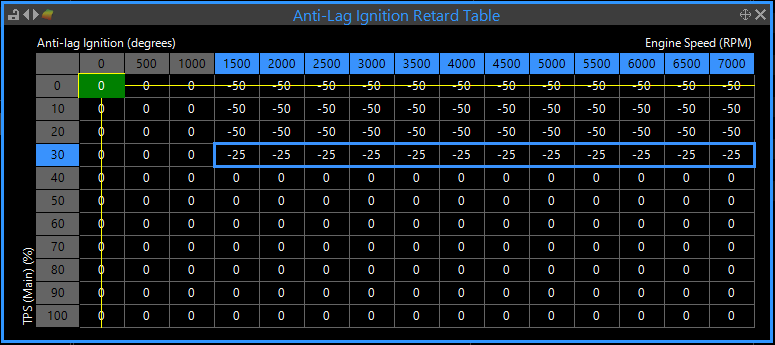This table allows the ignition timing to be retarded as a function of the current engine speed and throttle position (TP(Main)) while Anti-Lag is active. The operation of this table depends on the AL Ign Retard Mode setting found in the Anti-Lag setup options.
Note: Ignition retard should only be used in areas where Anti-Lag is required (e.g overrun). At high loads (for example from half to full throttle) all values should be zero so that no retard is used.
AL Ign Retard Mode settings effect the numbers used in the Anti-Lag Ign Retard Table as follows:
·Degrees - Anti-Lag Retard Table numbers represent the number of degrees advance that will be added to the current ignition timing. Negative numbers represent retard. A table number of -40 will result in ignition timing being 40 degrees more retarded than normal.
·Degrees Absolute - Anti-Lag Retard Table numbers represent the actual ignition timing used when Anti-Lag is active. If a number of -20 is entered, the actual timing while Anti-Lag is active will be 20 degrees retarded. Note that in this mode a value of zero in the Anti-Lag Ign Retard Table will result in the normal ignition timing being used.
Anti-Lag Ignition Retard Example
If AL Ign Retard Mode is set to Degrees the table will behave as follows:
Typically the Anti-Lag Ign Retard Table will contain values between about -25 and -50 degrees in the areas where Anti-Lag should operate (typically between 1500 and 7000 RPM and less than about 30% throttle. An example Anti-Lag Ign Retard Table is shown below:

Typical Anti-lag Ignition Trim Table (Degrees Trim)
So while Anti-Lag is active, at a throttle position of 20% and 5500 RPM, 50 degrees of timing will be removed from the normal ignition timing. So if the normal ignition timing was 25 degrees, the actual timing while Anti-Lag is active would be 35 degrees after top dead centre.


